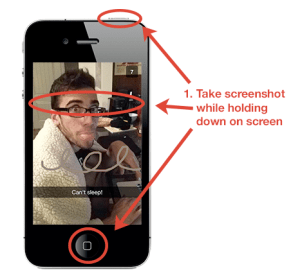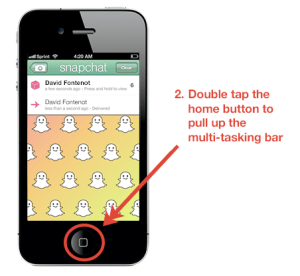Not-So-Ephemeral Messaging: New SnapChat “Hack” Lets Users Save Photos Forever

Nonetheless, evidence has surfaced that could threaten SnapChat’s private world of ephemeral messaging, bringing those innocent photos or salacious sexts to light. Alexia, via Buzzfeed, reported on SnapChat’s first “security loophole,” which showed that “snaps” could be accessed via temporary files stored on users’ iPhones and other iOS devices. While Alexia makes the good point that few beyond tech reporters are likely to go to the trouble of unearthing these snaps, we’ve now been alerted to another hack that allows users to capture “snaps” on their iOS devices and doesn’t require you to use iExplorer or iFunBox.
Instead, this hack allows you to easily save screenshots of “snaps” in a few simple steps, with no more than SnapChat and your multitasking bar.
The loophole comes to you courtesy of college student, hacker and web designer Raj Vir, who tells us that, “unknown to many, photos sent via SnapChat can be easily saved,” which he thinks could just “threaten the very impermanent nature of the app.”
How? Usually, when a user takes a screenshot of a SnapChat photo, the sender is immediately notified, but, according to Vir, it turns out that it’s possible to take “secret screenshots” that don’t in fact notify the sender at all.
But don’t just take Raj’s word for it, try it yourself.
 Here’s how it works:
Here’s how it works:- While viewing a SnapChat photo, take a screenshot by pressing the home and power button at the same time, while making sure to continue holding on the screen in order to ensure that the picture gets captured.
- After taking the screenshot, the photo won’t show on the screen and you will be brought back to your list of snaps.
- Before the photo expires, double tap the home button to bring up the multitasking bar. Once you’ve brought that up, SnapChat won’t recognize your screenshot.
 Why does this work? Vir explains that it has to do with the way SnapChat detects screenshots in iOS. Taking a screenshot interrupts any touch events on the screen and, as such, SnapChat intercepts touch cancellation events, determining that you have taken a screenshot. Some other events, however, also interrupt touch events: Namely, notifications and the multitasking bar.
Why does this work? Vir explains that it has to do with the way SnapChat detects screenshots in iOS. Taking a screenshot interrupts any touch events on the screen and, as such, SnapChat intercepts touch cancellation events, determining that you have taken a screenshot. Some other events, however, also interrupt touch events: Namely, notifications and the multitasking bar.SnapChat generally accounts for this by voiding the screenshot detection of the picture if the app entered the background or became inactive, he says, so if you take a screenshot and then summon the multi-tasking bar — as seen above — SnapChat will determine the action to be a screenshot and not the alternative.
From Vir’s testing, this method works on all versions of SnapChat on iOS. However, it does not work on Facebook’s Poke, which should be of interest to the SnapChat team. Or not. SnapChat CEO Evan Spiegel shrugged off the last reported hack and didn’t seem to fazed. This, however, is easy enough that any novice SnapChat user can do it — even if it requires some dexterity of the fingers, a little legerdemain, if you will.
Of course, while SnapChat will likely be able to close this loophole without moving mountains, Vir says that there isn’t an official iOS method for detecting screenshots, so it’s likely that another method will surface even if this is fixed and that there are several ways — albeit more complicated — to take secret screenshots on iOS without using this method. The point is that this problem could persist.
Whether it truly poses a threat to SnapChat’s ephemeral photo magic remains to be seen — probably not — but it could be enough to make users think twice before sending anything too incriminating. Not that SnapChat is ever used to send incriminating photos. I would know absolutely nothing about that. Nothing.
After all, since Zuckerberg and company launched Poke, others have followed suit with SnapChat clones and, while some may have thought that would put a damper on the app’s growth, it’s continued to hockey-stick nonetheless.
Is it a salacious social network that lures innocent teens into a giant sexting ring, or is it something else entirely? The fact of the matter is, as Jordan so astutely points out, in the world of social media, where everything is public, there can be a lot of pressure to maintain a positive residual/digital self-image. Ephemeral, or self-destructive messaging apps give users the opportunity to be goofy — to be controversial — in privacy, without sharing it with their entire social network. Sure this leads to sexting, but most of the traffic on SnapChat is far less prurient.
Either way, a sexting conspiracy it most definitely is not. SnapChat has been out to put a limit on photo messaging, turning it into a memory and not something that is permanent and forever tangible — and for this reason it’s struck a chord. Whether or not these sorts of hacks can lead to an unravelling of these tenets remains to be seen, but my guess is probably not. The ephemeral message is here to stay, whether a feature or a billion dollar business.
Thanks to Raj Vir for his help and for bringing this to our attention.